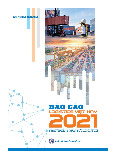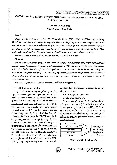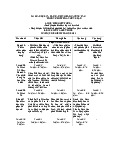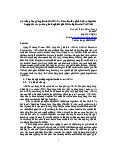



















Preview text:
1988-2018 THE HARMONIZED SYSTEM A universal language for international trade 30 Years On Harmonized System 30 Years On
On this occasion of the Harmonized System’s 30th PREFACE
Anniversary, the “Harmonized System Compendium
– 30 Years On” has been published, an updated
and expanded version of the existing “Customs
Compendium" to meet the needs of a new generation of Customs.
The original “Customs Compendium” series was
published in 2006. It was created to address topics
arising directly out of issues, questions and concerns
raised by the Director Generals of Customs. The
intention of those reference documents was not
only to provide information and food for thought for
Customs administrations, but also for their partners and the general public.
The WCO’s 183 Member administrations together
process 98% of international trade and have
incomparable technical expertise and knowledge of
Customs matters related to the classification of goods.
The Harmonized Commodity Description and Coding
System (HS) contributes to the harmonization of
Customs and trade procedures, and non-documentary trade data interchange.
The objective of this publication is to provide
a comprehensive description of the essential instrument
which is the Harmonized System, encompassing its
inception, how it works, its amendment and updating
processes, and its application. This new volume is a
highly topical addition to the collection, as the latest
edition of the Harmonized System entered into force on 1 January 2017.
Against that background, this publication constitutes
a useful work of reference and the WCO hopes that you will find it of interest. World Customs Organization | 1 Harmonized System 30 Years On TABLE OF INTRODUCTION 04 CONTENTS HISTORY 06 THE INTERNATIONAL 14 CONVENTION ON THE HARMONIZED COMMODITY DESCRIPTION AND CODING SYSTEM DESCRIPTION OF THE HS 18 STRUCTURE OF THE HS 21 2 | World Customs Organization Harmonized System 30 Years On MAINTENANCE OF THE HS THE COMPENDIUM 29 43 OF CLASSIFICATION OPINIONS AMENDING THE HS FUTURE DIRECTIONS 35 45 DISPUTE SETTLEMENT CONCLUSION 38 46 THE HS SIXTH EDITION ANNEX – THE DEVELOPERS 40 47 (2017) OF THE HS THE EXPLANATORY NOTES 42 World Customs Organization | 3 Harmonized System 30 Years On INTRODUCTION 4 | World Customs Organization Harmonized System 30 Years On
With over US$ 15 trillion worth of goods moving
While the HS has many uses, its first and fundamental
around the world, how do you know what is crossing
purpose is the categorisation of goods so that your border?
governments can assign and collect import duties and
taxes. The WCO has 183 Members (as of December
This is the issue that the Harmonized Commodity
2018), approximately three quarters of which could be
Description and Coding System (popularly known
characterized as developing or in transition to a market
as the Harmonized System or the HS) is designed to
economy. A large percentage of these Members
address. It is a nomenclature which enables all physical
depend to an important extent on Customs duties for
goods moving across borders to be assigned to a class their national revenues.
in a uniform manner all over the world.
However, the HS is more than just a tool for creating
Thanks to its versatile structure and multipurpose
tariffs for duty collection. It is used within many
nature, the HS is a true “language of international
other areas of government regulation and business
trade”. It is used, as of December 2018, as the basis for
practices, for example, rules of origin, monitoring of
Customs tariffs and for the compilation of international
controlled goods, internal taxes, freight tariffs, quota
trade statistics, by more than 200 economies and
controls and statistical reporting. The statistical data
Customs or Economic Unions (of which 157 are
it provides is developed into national and international
Contracting Parties to the HS Convention).
trade information that informs trade policy, economic
research and analysis, and corporate decisions.
The HS is one of the most successful instruments
developed by the World Customs Organization
Goods need to be properly classified to enable correct
(WCO) because it addresses a fundamental need of
revenue collection. In addition, accurate classification is
governments: the ability to categorize what is being
required to ensure that the use of the HS in regulating
traded. This enables both decisions on immediate
trade and in providing the data for trade statistics and
actions for specific goods (for example duty collections,
policy is not compromised. The more accurate the
restrictions or controls) and the use of the collated
application of the HS, the more it serves the needs of
information to underpin economic and trade related its users. policies and planning.
This serves to emphasize the importance of proper
Governments and businesses alike use the HS’s
application of the HS for day-to-day Customs work,
identification and coding of merchandise to facilitate policy development and trade.
international trade and regulation. The HS is, therefore,
an important instrument not only for the WCO but also
for all institutions, public or private, involved in world trade. World Customs Organization | 5 Harmonized System 30 Years On HISTORY
“Imported commodities shall pay 1/5th of their value as toll.”
“Wool dyed purple. For each fleece
imported or exported, three denarii”
“Of cloths (vastra), quadrupeds, bipeds,
threads, cotton, scents, medicines,
“Per camel load of olive oil comprising
wood, bamboo, fibres (valkala), skins,
of four goatskin bags, ten denarii at
and clay-pots; of grains, oils, sugar (ks- importation and exportation”
hdra), salt, liquor (madya) cooked rice
and the like, he shall receive 1/20th or
From the tariff of ancient Palmyra from 1/25th as toll.” the year 137 AD
From “Arthashastra”, ancient Indian
text, credited to Kautilya (4th century BC)
Tariffs have probably been in existence for as long
nomenclature. This was also favoured by business. At
as governments. However early tariffs were simple
the International Commercial Congress in Paris in 1889
lists of goods and the amount payable, usually by
the question was put: “Would it not be in the interest
consignment, quantity or as a percentage of value.
of all nations to adopt in their Customs tariffs and in
their official statistics comparable classifications and
Such lists worked well when there were only a uniform vocabularies?”
relatively few, simply defined commodities and their
only use was revenue collection. However, over the
Although the extreme difficulty of constructing a
last century and a half, the range and complexity of
uniform vocabulary for goods was recognised, the
goods traded has grown well beyond what could have
idea was firmly implanted and there were successive
been imagined by previous Customs administrations.
attempts on national and international levels to
At the same time, the demand for detailed information advance this aim.
on trade, including on international trade patterns, has grown with that expansion.
In 1931, the League of Nations’ “Sub-Committee
of Experts for the Unification of Customs Tariff
This need for information makes it unsurprising Nomenclature” completed its “Draft Customs
that the convergence between statistical and tariff
Nomenclature”, commonly referred to as the Geneva
nomenclatures has increased over time and that the
Nomenclature, and the document was opened for
first attempts at an international tariff nomenclature
comments from governments of member states. The arose from statisticians.
Geneva Nomenclature had 941 four-digit headings,
organised into 86 Chapters grouped into 21 Sections.
During the nine International Statistical Congresses
The comments were incorporated and a revised
that were held between 1853 and 1876, the idea was
version was issued in 1937. Unfortunately, the outbreak
elaborated that an international tariff was a necessary
of the Second World War prematurely halted work on
prerequisite to any attempt at an international statistical
the widespread adoption of the Nomenclature. 6 | World Customs Organization Harmonized System 30 Years On
BRUSSELS CONVENTION ON NOMENCLATURE FOR THE CLASSIFICATION OF GOODS IN CUSTOMS TARIFFS
The drive for economic reconstruction and the desire
The CCCN took the form of a systematic list of goods.
for greater freedom of trade following the Second
It comprised 1,241 headings (1,011 headings until 1987)
World War renewed the emphasis on Customs tariffs,
divided among 96 Chapters (99 Chapters until 1987),
and the need for an internationally recognized common
themselves arranged in 21 Sections. Each heading was
nomenclature once again became a priority.
identified by two groups of two digits each: the first
group represented the Chapter in which the heading
It was natural that the work done from 1948 onwards by
appeared, while the second indicated its position in
the European Customs Union Study Group with a view that Chapter.
to preparing a common Customs tariff for use by all
participating countries should be based on the Geneva
The Nomenclature Convention made special provision
Nomenclature. It was the only standard framework of its
for the administration of the new instrument (the
kind available at that time. Nevertheless, considerable
Nomenclature Committee), and laid down a procedure
amendments were made to the Geneva text, partly
for its periodic updating. The CCCN was updated on 1
to reflect technical progress and partly because of
January 1965 (first three Recommendations), 1 January
shortcomings revealed by the experience of countries
1972, 1 January 1978 and 1 January 1988.
that had already adopted Geneva-type tariffs.
There is no doubt that these measures, which
In 1949, a preliminary draft containing headings and
represented a significant advance over the Geneva
subheadings that had been produced was issued. The
Nomenclature, were instrumental in the success of the
Study Group decided that the immediate need for a new Convention.
common nomenclature must be satisfied. Irrespective
of the progress which might be made on the European
Until 1987, fifty-two countries were Contracting Parties
Customs Union project, the very valuable results
to the Nomenclature Convention. In actual fact over 150
already attained in the field of nomenclature should be
countries and territories used the CCC Nomenclature
turned to advantage. It was accordingly decided that
as a basis for their Customs tariffs.
the headings of the preliminary draft Nomenclature
(other than the subheadings, which were left to the
The CCC Nomenclature was supported by:
initiative of individual countries), should be established by a Convention. •
Explanatory Notes which, although not part of
the 1950 Nomenclature Convention, constituted
It was this 1949 draft, which, rearranged, abridged and
the official interpretation of the Nomenclature as
simplified, became, on 15 December 1950, the Brussels
approved by the Customs Co-operation Council;
Convention on Nomenclature for the Classification of
Goods in Customs Tariffs. This Convention was opened •
An Alphabetical Index listing all the goods referred
for signature at the same time as the Convention
to or described in the Nomenclature and the
establishing a Customs Co-operation Council and the Explanatory Notes;
Convention on the Valuation of Goods for Customs
Purposes. It came into force on 11 September 1959, •
A Compendium of Classification Opinions listing
following the adoption, on 1 July 1955, of a Protocol
all the Classification Opinions adopted by the CCC
of Amendment establishing a revised version of the
as a result of the study of classification questions Nomenclature.
which had been brought to its attention.
This Nomenclature was initially known as the
“Brussels (Tariff) Nomenclature” (BTN), but in 1974
it was renamed the “Customs Co-operation Council
Nomenclature” (CCCN), to avoid any confusion as to
the international organisation responsible. World Customs Organization | 7 Harmonized System 30 Years On Figure 1. Brussels Tariff Nomenclature (BTN) adopted in 1955
INTERNATIONAL CONVENTION ON THE HARMONIZED COMMODITY DESCRIPTION AND CODING SYSTEM
In the late 1960’s there was a growing awareness of
Early in 1970, representatives of the Customs Co-
the need to further rationalize and harmonize trade
operation Council discussed these developments with
documentation data and, in particular, to harmonize the
other international organizations and, at a meeting
designation and coding of countries, units of quantity,
of the Economic Commission for Europe, it was
modes of transport, transport handling requirements
agreed that the Council was the organization best
and, not least, commodities. Many studies had shown
suited to sponsor a study of the problems related
the immense costs involved for the public and private
to commodity description and coding. The Council
sectors in maintaining different product classification
set up a Study Group to examine the possibility of
systems in different countries. Indeed, it had been
preparing a Harmonized Commodity Description
found that a commodity could be designated up to 17
and Coding System capable of meeting the principal
times in the course of a single international transaction.
requirements of Customs authorities, statisticians,
carriers and producers. In addition to the CCCN, the
The development of automatic data transmission
Study Group examined the “Standard International
techniques did, it is true, offer a solution to this
Trade Classification” (SITC) as a classification tool. The
problem, but only if an internationally recognized
SITC was intended to be used by governments for
code was available for identifying the goods. While
their external trade statistics.
it was recognized that the problem could not be
entirely eliminated, further harmonizing commodity
classification would alleviate the problem.
In its final Report, approved by the Council in May 1973,
the Study Group concluded that:
The focal point for these studies was the Economic
Commission for Europe, via its Working Party on
a) the development of a Harmonized Commodity
Facilitation of International Trade Procedures and
Description and Coding System was not only
a Group of Experts on data requirements and
feasible but essential in the longer-term interests documentation.
of the facilitation of international trade; 8 | World Customs Organization Harmonized System 30 Years On
b) the System should be developed from the CCCN
the System should be representative of all the interests
and SITC (revised). However, the work done to
involved. Consequently, in addition to delegates from
date demonstrated a need for some changes in
the Customs administrations of various Council Member
these two instruments, to bring them into step
States, the Committee included representatives of a
with current trade conditions; in addition, it would
number of national or international organizations. In
be advisable to modify some parts of the CCCN
carrying out the technical work involved, the Committee
to facilitate establishment of the Harmonized
was assisted by a Working Party, made up of members
Commodity Description and Coding System; of
of the Committee itself together with representatives
course, after the System had been developed,
of other countries (some of them not Members of the
steps would have to be taken to ensure that it be
Council) and of other organizations. revised as necessary;
The interest and support for this proposal resulted in
c) the CCCN would constitute the core of the
almost 60 countries and more than 20 international
Harmonized System. It should continue to be
and national organizations taking part in the activities
maintained under the provisions of the current
of the Harmonized System Committee and its Working
Convention, as a separate 4-digit entity;
Party (with their proposals, comments on proposals
or participation in the decision making procedure).
d) during the development of the System, account
Representatives of national administrations using
should be taken of existing nomenclatures and
tariffs not based on the CCCN, together with the
commodity description systems which were
United Nations Statistical Office, the United Nations
primarily representative of Customs, statistical and
Conference on Trade and Development (UNCTAD), transport requirements;
the General Agreement on Tariffs and Trade (GATT),
the International Organization for Standardization
e) the System should be developed under the
(ISO), the International Chamber of Commerce (ICC),
auspices of the Customs Co-operation Council,
the International Chamber of Shipping (ICS), the
but an international/ interorganizational body
International Air Transport Association (IATA) and the
should be maintained in existence throughout the
International Union of Railways (UIC) took part in the
development period to ensure that the needs of development.
all interests involved were fully taken into account
and to plan the implementation of the Harmonized
In accordance with the general principles established System.
by the Study Group, the Harmonized System not only
had to be developed from the CCCN and SITC, Rev.2
When the Council approved the Study Group's Report,
(which was correlated to the CCCN), but also took
it also set up a Harmonized System Committee to
account of a wide range of other classification systems.
prepare the Harmonized System, in accordance with
These included tariff or statistical nomenclatures, some
the guidelines laid down by the Study Group, and to
of which were based on the CCCN (Customs Tariff of
draft the text of the instrument under which it would be
Japan, Tariff Nomenclature for the Latin American
implemented. In addition, it set up a special unit in the
Free Trade Association (NABALALC), Nomenclature
Council's Secretariat, known as the Technical Team, to
of Goods for the External Trade Statistics of the
serve the new Committee and to draft initial proposals
(European) Community and Statistics of Trade between
for the Harmonized System. The Deputy Secretary
Member States (NIMEXE)), whilst others had been
General (and later an Assistant Secretary General)
developed independently (Customs Tariff of Canada,
of the Council was put in charge of the Technical
Customs Tariff of the United States, "Import Commodity
Team and became the Chairman of the Harmonized
Classification'' and "Export Commodity Classification"
System Committee. The Nomenclature Directorate of
(Canada), "Schedule B (Export)" (United States)). They
the Council's Secretariat gave its full support to the
also considered transport nomenclatures such as the Technical Team.
International Union of Railways' Standard Commodity
Nomenclature (NUM), the International Air Transport
As the principal objective of the Harmonized System
Association's "Worldwide Air Cargo Commodity
was to meet the needs of all those concerned with
Classification'' (WACCC), the Freight Tariff of the
world trade (Customs, international trade statistics,
Association of West India Trans-Atlantic Steamship
transport), it was important that the Harmonized
Lines (WIFT) and the "Standard Transportation
System Committee set up by the Council to prepare Commodity Code" (STCC). World Customs Organization | 9




